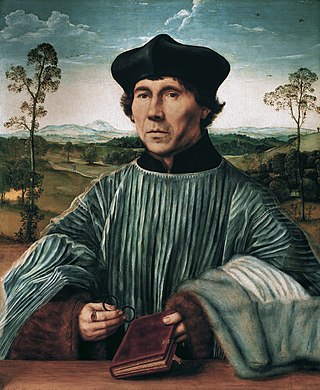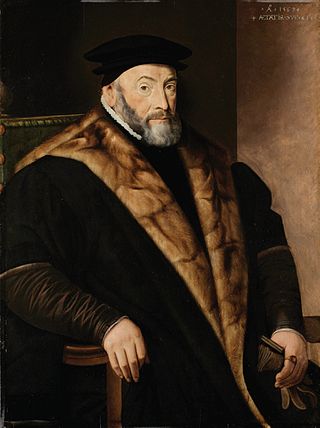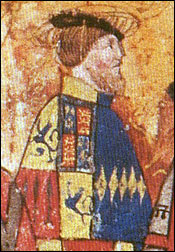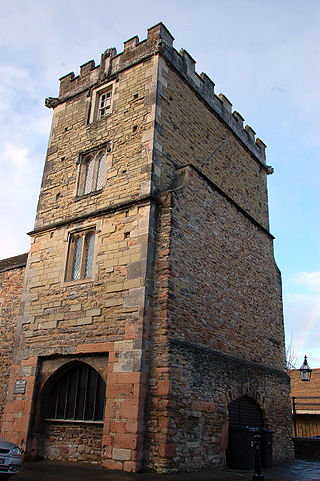Life
He graduated M.A. at the University of Oxford in 1521. [1]
Barlow was intimately involved in the King's attempts to secure a divorce from his first wife, Katherine of Aragon from the Pope. Barlow was a supporter of Henry's fiancée, Anne Boleyn. Barlow uncovered evidence of Cardinal Wolsey's betrayal of the King's cause in Rome, which he faithfully reported to a horrified Anne in 1528. This information helped solidify the future queen's hatred towards Wolsey, something which played a major part in the Cardinal's fall from power the following year.
Barlow is described as one of her [Anne Boleyn's] favourite clerics. [2] In June 1530 he was appointed dean of the College of Westbury-on-Trym, just outside Bristol, but actually in the diocese of Worcester. [3] On the dissolution of the College in 1544, Barlow became dean of Worcester. [1] His closeness to Anne Boleyn led some to suggest he must have known of her 'treason.' [4] One unfortunate Welsh vicar who suggested this was hounded by Barlow who was intolerant and confrontational.' [5] Barlow was Dean of Worcester from 1544 until he was deprived of the role under Queen Mary in 1553. [6]

Anne Boleyn was Queen of England from 1533 to 1536, as the second wife of King Henry VIII. The circumstances of her marriage and execution, by beheading for treason, made her a key figure in the political and religious upheaval that marked the start of the English Reformation.

Anne of the Thousand Days is a 1969 British historical drama film based on the life of Anne Boleyn, directed by Charles Jarrott and produced by Hal B. Wallis. The screenplay by Bridget Boland and John Hale is an adaptation of the 1948 play of the same name by Maxwell Anderson.

William II Canynges (c. 1399–1474) was an English merchant and shipper from Bristol, one of the wealthiest private citizens of his day and an occasional royal financier. He served as Mayor of Bristol five times and as MP for Bristol thrice. He was a generous patron of the arts in Bristol, particularly concerning the church of St Mary Redcliffe in Bristol, "The crown of Bristol architecture". Following the death of his wife Joan in 1467, he renounced civic and commercial life and was ordained a priest in 1468, in which capacity he remained until his death six years later. His tomb effigy in St Mary's later inspired the boy poet Thomas Chatterton to write the romantic poem "The Storie of William Canynge".

George Boleyn, Viscount Rochford was an English courtier and nobleman who played a prominent role in the politics of the early 1530s as the brother of Anne Boleyn, second wife of King Henry VIII. George was the maternal uncle of Queen Elizabeth I, although he died long before his niece ascended the throne. Following his father's promotion in the peerage in 1529 to Earl of Wiltshire and Earl of Ormond, he adopted his father's junior title Viscount Rochford as a courtesy title. He was accused of incest with his sister Anne during the period of her trial for high treason, as a result of which both were executed.

Stephen Gardiner was an English Catholic bishop and politician during the English Reformation period who served as Lord Chancellor during the reign of Queen Mary I and King Philip.

Thomas Audley, 1st Baron Audley of Walden KG, PC, KS, JP, was an English barrister and judge who served as Lord Chancellor of England from 1533 to 1544.

Henry Percy, 6th Earl of Northumberland, KG was an English nobleman, active as a military officer in the north. He is now primarily remembered as the betrothed of Anne Boleyn, whom he was forced to give up before she became involved with and later married King Henry VIII.
Bishop Rowland Lee was an English clergyman who served as Bishop of Coventry and Lichfield 1534–43 and also as Lord President of the Marches under King Henry VIII.

Westbury-on-Trym is a suburb in the north of the City of Bristol, near the suburbs of Stoke Bishop, Westbury Park, Henleaze, Southmead and Henbury, in the southwest of England.

Westbury College Gatehouse is a 15th-century gatehouse to the 13th-century College of Priests located in Westbury-on-Trym, Bristol, England, and now a National Trust property.
Henry Norris was an English courtier who was Groom of the Stool in the privy chamber of King Henry VIII. While a close servant of the King, he also supported the faction in court led by Queen Anne Boleyn, and when Anne fell out of favour, he was among those accused of treason and adultery with her. He was found guilty and executed, together with the Queen's brother, George Boleyn, Viscount Rochford, Sir Francis Weston, William Brereton and Mark Smeaton. Most historical authorities argue that the accusations were untrue and part of a plot to get rid of Anne.
William Brereton, c. 1487/1490 – 17 May 1536, was a member of a prominent Cheshire family who served as a courtier to Henry VIII. In May 1536, Brereton was accused of committing adultery with Anne Boleyn, the king's second wife, and executed for treason along with her brother George Boleyn, Henry Norris, Francis Weston and a musician, Mark Smeaton. Most historians are now of the opinion that Anne Boleyn, Brereton and their co-accused were innocent.

Holy Trinity Church is a Church of England parish church in Westbury-on-Trym, Bristol, England.
John Carpenter (1399–1476) was an English bishop, provost, and university chancellor.
Events from the 1500s in England.
William Barlow was an English Augustinian prior turned bishop of four dioceses, a complex figure of the Protestant Reformation. Aspects of his life await scholarly clarification. Labelled by some a "weathercock reformer", he was in fact a staunch evangelical, an anti-Catholic and collaborator in the Dissolution of the Monasteries and dismantling of church estates; and largely consistent in his approach, apart from an early anti-Lutheran tract and a supposed recantation under Mary I. He was one of the four consecrators and the principal consecrator of Matthew Parker, as archbishop of Canterbury in 1559.
Sir Edward Bayntun, of Bromham, Wiltshire, was a gentleman at the court of Henry VIII of England. He was vice-chamberlain to Anne Boleyn, the King's second wife, and was the brother-in-law of Queen Katherine Howard, Henry VIII's fifth wife.
William Betts or Bettes was a clergyman who became the chaplain and close supporter of Anne Boleyn, the second wife of King Henry VIII of England. He was an associate of Matthew Parker, who on Betts' death was given his position as the Queen's chaplain, before going on to become archbishop of Canterbury.
Joan Larke was the mistress of the powerful English statesman and churchman in the Tudor period, Thomas Wolsey, Archbishop of York, and mother of his two illegitimate children.

Anne Gainsford, Lady Zouche was a close friend and lady-in-waiting to Queen consort Anne Boleyn.










